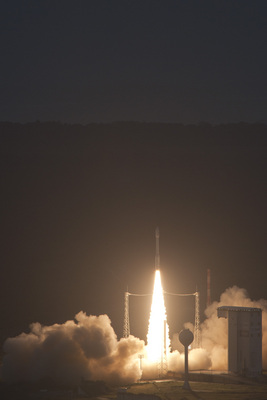- Joined
- Oct 30, 2009
- Messages
- 14,020
- Reaction score
- 4
- Points
- 0
ESA:
Vega set for its inaugural flight
3 February 2012
PR 2 2012 - On 13 February, the European Space Agency will perform the first qualification flight of its brand new Vega launch vehicle.
The very first Vega will lift off from Europe’s spaceport in Kourou, French Guiana, to release nine satellites into orbit and add a new capability to Europe’s fleet of launch systems.
The first mission, designated VV01, is scheduled for liftoff during a two-hour launch window during 10:00–12:00 GMT (11:00–13:00 CET; 07:00–09:00 local time)
This first flight marks the culmination of nine years of development by ESA and its partners, the Italian space agency (ASI) and ELV SpA, the prime contractor for developing the vehicle.
{...}
The payload consists of two Italian satellites – ASI’s LARES laser relativity satellite and the University of Bologna’s ALMASat-1 – as well as seven nanosatellites provided by European universities: e-St@r (Italy), Goliat (Romania), MaSat-1 (Hungary), PW-Sat (Poland), Robusta (France), UniCubeSat GG (Italy) and Xatcobeo (Spain).
The mission is intended to qualify the overall Vega system, including the vehicle itself, its launch infrastructure and the operations, from the launch campaign to the payload separation and safe disposal of the upper stage.
Following this qualification flight, the Vega launch system will be handed over to Arianespace to operate. The company will also be in charge of offering this new launch capacity on the international market, with the goal of at least two missions per year. ESA will be an early customer of Arianespace’s new service through a commitment for five launches.
{...}
Vega set for its inaugural flight
3 February 2012
PR 2 2012 - On 13 February, the European Space Agency will perform the first qualification flight of its brand new Vega launch vehicle.
The very first Vega will lift off from Europe’s spaceport in Kourou, French Guiana, to release nine satellites into orbit and add a new capability to Europe’s fleet of launch systems.
The first mission, designated VV01, is scheduled for liftoff during a two-hour launch window during 10:00–12:00 GMT (11:00–13:00 CET; 07:00–09:00 local time)
This first flight marks the culmination of nine years of development by ESA and its partners, the Italian space agency (ASI) and ELV SpA, the prime contractor for developing the vehicle.
{...}
The payload consists of two Italian satellites – ASI’s LARES laser relativity satellite and the University of Bologna’s ALMASat-1 – as well as seven nanosatellites provided by European universities: e-St@r (Italy), Goliat (Romania), MaSat-1 (Hungary), PW-Sat (Poland), Robusta (France), UniCubeSat GG (Italy) and Xatcobeo (Spain).
The mission is intended to qualify the overall Vega system, including the vehicle itself, its launch infrastructure and the operations, from the launch campaign to the payload separation and safe disposal of the upper stage.
Following this qualification flight, the Vega launch system will be handed over to Arianespace to operate. The company will also be in charge of offering this new launch capacity on the international market, with the goal of at least two missions per year. ESA will be an early customer of Arianespace’s new service through a commitment for five launches.
{...}



